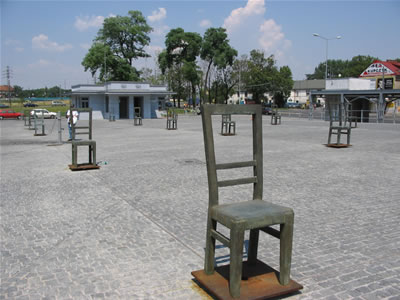Podgorze
On the 28th of February 1784, Austrian Emperor Joseph II declared a creation of the city of Podgorze. At that time Podgorze was built on the right side of the Vistula River to create an economical counter balance to still Polish Royal city of Cracow, standing proudly on the other side of Vistula. The river was a border line after the first partition of Poland in 1772. Throughout XIX century Podgorze was developed thanks to its privileged legal status in Austro-Hungarian Empire. Vicinity of Polish Cracow pushed Austrian administration to construct numerous fortifications, which later on would be developed all around Cracow area. Many of them are still in good shape and are certainly an attraction to some interested tourists. In 1915 Podgorze was merged with Cracow and became one of its most industrial districts.
Ghetto in Cracow
The tragic chapter of Podgorze history starts with World War II. In the early years of occupation thousands of ghettos were opened all over German occupied Poland. Hans Frank, the Nazi governor of General Government, with Cracow as its capital, was very reluctant to establish the Jewish ghetto in this city. Frank’s ambition was to make Cracow “Juden Rein”, cleared of all Jews and in this way make it an exemplary new German city. After massive deportations of Jews out of Cracow only in 1941 the ghetto had to be established for those remaining and Podgorze was chosen as its territory. It was a Nazi idea to push the Jews and ghetto as far as possible from the Cracow’s center. Podgorze behind Vistula River seemed to be a far enough location.

In March 1941 the borders of ghetto area were closed and all Jews found behind its gates were to be killed. Ghetto wall was built. In 1942 the decision about the “Final Solution” was taken. Jews from Podgorze were being gradually transported to the death camp in Belzec and some of them were moved to the nearby concentration camp in Plaszow. In March 1943 Podgorze ghetto was liquidated. The last groups of Jews were gathered on the Zgody Square, place used for roundups before deportations. Selection was started. Children, women, the sick and the old were shot in the courtyards of houses adjoining Zgody Square. Within few hours Germans murdered about 2000 people. Another 2000 were transported to the Auschwitz Birkenau death camp, were many were sent directly to the gas chambers. About 4000 people were lead to the Plaszow camp.
Schindler's Factory
The enamelware factory in Zablocie was working in the structures of Plaszow Camp. For its purposes a sub-camp called “Emalia” was created. Oscar Schindler – an industrialist from Sudeten land, a member of NSDAP was an owner. He came to Cracow just after the city was taken by Germans with an idea of making business. The place seemed to be perfect with abandoned factories, slave labor force and unlimited production orders by German army. Employment during the ghetto time was crucial because this was the only way not to undergo a deportation. Prisoners employed at the Schindler’s Factory were working hard, for 12 hours a day, but they were not exposed to torture, flogging and prolonged roll-calls, as was the case in other employment places. Several times Schindler was to save the lives of Jews who worked in his factory. He bribed higher officers of the SS when a life of his worker was at risk. In September 1944 he evacuated his factory and his almost 1200 workers to Brunlitz, where the prisoners were liberated in May 1945.

Nowadays, walking through the streets of Podgorze we can discover and trace the stories of many individuals and events in the ghetto. Original buildings are still there, not allowing us to forget the dramatic history of this place. Two remnants of ghetto wall help us to locate places on old photos taken in 1943. Zgody Squere was in 2005 commemorated with modern monument in the memory of all inhabitants and victims of the ghetto. Metal chairs scattered all over this place won’t let you pass this square without remembering its terrible past. The square also houses Pharmacy Under an Eagle which is now a museum documenting the ghetto history and life saving activities of the pharmacy owner, Tadeusz Pankiewicz, during the war. Only 5 minutes walk from there, we can reach actual buildings of the Schindler’s Factory.
In December 2008, after a few years of renovation works which were carried out in the Factory’s administrative building at Lipowa 4 street, a small part of the new museum was opened to public. Its exhibition is devoted to the history of Krakow in the time of German Nazi Occupation: 1939 – 1945. It puts Oscar Schindler and Jews rescued by him into a wider context of life and the Holocaust events which took place at that territory.
SCHINDLER'S FACTORY - Cracow under the German Nazi occupation from 1939 to 1945
In summer 2010 the Krakow's Historical Museum opened its new branch at the premises of the former Schindler’s Factory. This modern museum is to present the history of Krakow under the German Nazi occupation from 1939 to 1945. Large part of the exhibition is devoted to show life and annihilation of the Krakow’s ghetto. The museum is arranged chronologically, giving the visitor a unique opportunity to follow the war time narration and experience of occupation reality. The numerous artistic means and multimedia presentations enrich the exhibit and help to understand the complexity of Nazi occupation of Krakow and Poland. The first part of the exhibit narrates the city's cultural, ethnic and religious richness in the 20’s and 30’s of the XX century. Stereographic pictures take us into the streets of the city just before the war. Then comes the September Campaign and gradual implementation of the new Nazi regime aimed against local population. The museum creators were able to reconstruct city's streets, prison cells, war time apartments with an successful effort to show general anxiety, chaos and individual human tragedy inflicted by war. The exhibition has many layers of narration and in this way can satisfy people who want to have just a general orientation in the war time in Cracow as well as history experts looking for some additional history details.



